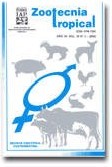
|
Zootecnia Tropical
Instituto Nacional de Investigaciones Agrícolas Venezuela
ISSN: 0798-7269
Vol. 28, No. 2, 2010, pp. 173-182
|
 Bioline Code: zt10019
Bioline Code: zt10019
Full paper language: English
Document type: Research Article
Document available free of charge
|
|
|
Zootecnia Tropical, Vol. 28, No. 2, 2010, pp. 173-182
| en |
Effects of the relation energy/ protein in the larvas of Coporo ( Prochidolus mariae  ) )
Hernández, Glenn; González, José; Alfonso, Edgar; Salmeron, Yaquelin & Pizzani, Pablo
Abstract
In order to determine the effect of the energy relation/protein in Copore larvae ( Prochidolus mariae

), 6 diets
formulated with increasing crude protein levels (30, 35 and 40%) and energy were used (2.500 and 3.000 Kcal/
kg). The gain of weight, length overall was registered weekly in the larvae and mortality, through a design
completely randomized with a factorial adjustment 2X3 (levels of energy x protein levels) to a meaning level α=
0,05. The weight average and length overall of the units, to the 15 days of culture, was superior (P <0,05) in the
protein diet/energy 40/2.500 (17,42 mg and 2,44 cm, respectively). The results of sobreexperience of the copore
larvae during the phase of rise did not differ between different diets (P >0,05), varying from 94 to 99%. The
chemical parameters physical of quality of water stayed constants. When the energy relation is analyzed/protein
of 2.500Kcal/kg/40% and 3.000Kcal/kg/40% is observed better answers the lowest value of energy, possibly due
to the smaller requirement of energy of the species, nevertheless can be due to the contribution of energy by the
protein. In the case of the lower power level, part of the protein, can be turned aside to the catabolic metabolism
instead of being used for the growth, the results show that the copore larvae require high exigencies, equal or
greater of 40% of crude protein in the diet and apparently they do not require more than 2.500 Kcal to make its
initial metabolism.
Keywords
requirement, energy, protein, larvae, Copore
|
| |
| es |
Efectos de la relación energía/proteína sobre el desempeño productivo en larvas de Coporo ( Prochidolus mariae  ) )
Hernández, Glenn; González, José; Alfonso, Edgar; Salmeron, Yaquelin & Pizzani, Pablo
Resumen
Para determinar el efecto de la relación de energía/proteína en larvas de Coporo ( Prochidolus mariae

), se utilizaron
6 dietas formuladas con niveles crecientes de proteína cruda (30, 35 y 40%) y energía (2.500 y 3.000 Kcal/kg). Se
registró semanalmente en las larvas la ganancia de peso (GP), longitud total (LT) y mortalidad (M), a través de un
diseño completamente aleatorizado con un arreglo factorial 2X3 (niveles de energía x niveles de proteína) a un
nivel de significación α= 0,05. El peso promedio y LT de los ejemplares, a los 15 días de cultivo, fueron superior
(P < 0,05), en la dieta de proteína/energía 40/2.500 (17,42 mg y 2,44 cm, respectivamente). Los resultados de
sobrevivencia de las larvas de Coporo durante la fase de levantamiento no difirieron entre las diferentes dietas
(P > 0,05), variando de 94 a 99%. Los parámetros físico químicos de calidad de agua se mantuvieron constantes.
Cuando se analiza la relación de energía/proteína de 2.500Kcal/kg/40% y 3.000Kcal/kg/40% se observa mejores
respuestas al más bajo valor de energía, posiblemente debido al menor requerimiento de energía de la especie, sin
embargo, puede deberse al aporte de energía por la proteína. En el caso del nivel energético más bajo, parte de
la proteína, puede haber sido desviada al metabolismo catabólico en vez de emplearse para el crecimiento. Los
resultados muestran que las larvas de Coporo requieren exigencias altas, igual o mayor de 40% de proteína cruda
en la dieta y aparentemente no requieren más de 2.500 Kcal para realizar su metabolismo inicial.
Palabras-clave
requerimiento, energía, proteína, larvas, Coporo.
|
| |
© Copyright 2010 - Zootecnia Tropical
Alternative site location: http://www.sian.inia.gob.ve/repositorio/revistas_ci/ZootecniaTropical/ztindice.htm
|
|
